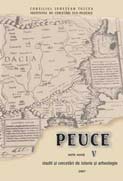Mangalia. Cercetări arheologice de salvare
Mangalia. Preventive Archaeological Research
Author(s): Nicolae Alexandru, Laurenţiu Radu, Robert Constantin, Mihai IonescuSubject(s): Archaeology
Published by: Institutul de Cercetari Eco-Muzeale Tulcea - Institutul de Istorie si Arheologie
Keywords: Mangalia; necropolis; Roman tombs; Hellenistic tombs; Muslim tombs; incineration; inhumation; necropolă; morminte romane; morminte elenistice; morminte musulmane; incineraţie; înhumaţie
Summary/Abstract: This study presents the results of a preventive archaeological excavation that took place in 2003, in an area situated in the vicinity of Oituz Street, Mangalia. On 5568 square meters surface, we identified and excavated 285 tombs: 270 of those were inhumation graves with sidelong recess, part of an Islamite rite necropolis (18th-20th centuries). The 15 ancient tombs are classified into: Hellenistic period tombs (11), belonging to the following types: a.-incineration tombs (two of “rug busta” type, covered with tegulae and one in urn) and b.-inhumation ones: in stone-box constructions or in plain, unsubdivided pit covered with limestone blocks and one grave using the prolongation recess for the deceased these are dating back from the 1st to the 2nd centuries B.C). We identified only three Early Roman funereal complexes-one using the urn incineration rite and ritual (the 4th century A.D) and two inhumation tombs with prolongation recess, with dromos and funereal chamber (datable between 2nd to 3rd centuries A.D.). Situated outside the inhabited area of the ancient city, the tombs were arranged into plots or groups, which did not seem to cover a certain area in some organized manner. The criteria based on which the burials were performed seemed to be simply the ownership rights.
Journal: Peuce (Serie Nouă) - Studii şi cercetari de istorie şi arheologie
- Issue Year: V/2007
- Issue No: 5
- Page Range: 241-296
- Page Count: 56
- Language: Romanian

